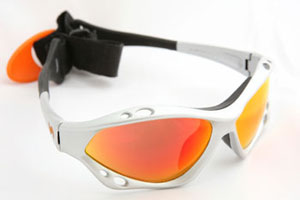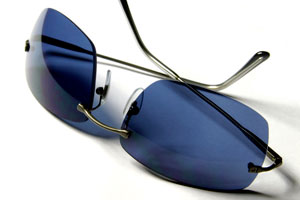Sport Lenses
 If you play sports, you should keep two things in mind related to your vision: protection and precision.
If you play sports, you should keep two things in mind related to your vision: protection and precision.
Sports lenses protect the wearer’s eyes. Sports such as tennis, baseball, softball, and racquetball may see ball speeds of 90 mph or more. In baseball alone, there are over 500,000 injuries per year! But that is not the most common cause of sports-related eye injuries. Most eye injuries occur in basketball, where an elbow or a finger jabbed into the eye can cause corneal abrasions, fractured bones, retinal detachments, or even blindness. That's why protective eyewear is an important consideration when playing sports and why polycarbonate lenses are the best material to use. Polycarbonate lenses are more resistant to impact than glass or plastic because they are stronger and offer protection for 90% of eye injuries. Protective eyewear fits well, features a padded bridge, comes in prescription or non-prescription lenses and has deep-grooved eyewires to prevent the lens from falling out.
Specialized lenses also optimize your vision when you're out in the sun improving clarity and comfort. Depending on your sport, certain lenses are more appropriate than others. Neutral gray tint lenses keep color perception 100% true while cutting glare and providing good contrast. Gray tint can be used as an all purpose tint for many outdoor activities including baseball, snow sports and golf. Gray tints may range from a visible light transmission of 7% for snow sports in clear, sunny conditions to 15% for general use. Yellow, orange and brown tints are recommended for skiing, mountaineering, baseball/softball and shooting activities because these tints transmit more of the longer wavelengths near the peak sensitivity of the human eye (yellow) and have a brightening effect. Yellow lenses filter blue light to enhance contrast for hazy or overcast days. They can be helpful for shooters or skiers but can interfere with accurate color perception. Golfers and tennis players may benefit from brown or amber colored lenses which enhance contrast and make it easier to follow the ball. Green tints are most soothing to the eye and may be helpful for hunting, tennis, drivers and golfers. Red tints are used in trap and skeet shooting to enhance the reddish orange color of the sporting clay and by skiers in flat light conditions. Polarized lenses are great for water and snow sports during bright sunny conditions to cut glare but are not for every situation such as golf where they can interfere with reading the subtle contours of the green. Many professional golfers don't wear polarized lenses for this reason. Even if you do not normally wear glasses, non-prescription sports lenses can benefit your performance. Some people think that lenses prevent the wearer from seeing the action, but many sports lenses have anti-fog, glare reduction, and scratch resistant properties. Some are also designed to maximize peripheral vision.
Sunwear
 Sunglasses are as much about function as they are about fashion. To reduce exposure to UV radiation (290-400 nanometer wavelengths) and its effects, we recommend you invest in a set of quality sunglasses which can provide at least 99% protection from UVA (320-400nm) and UVB (290-320nm) rays. UV radiation promotes skin cancer of the lids and skin around your eyes, photokeratitis (cell damage to cornea), cataracts, retinal damage (macular degeneration) and growths on the surface of the eye such as pinguecula and pterygia. High energy visible radiation (blue light 400-500 nm) is also associated with retinal damage. UV radiation increases 4-5% as elevation increases every 1000 feet, so living in Las Vegas at slightly over 2000 feet above sea level increases exposure 8-10%. The problem with cheap sunglasses is how they are made. They are ordinary plastic with a thin tint coating on them. When you buy a pair of cheap sunglasses, you could make things worse by increasing your exposure to UV radiation if they have no UV protection. The tint reduces brightness causing your iris to open more. This allows additional UV radiation into the eye increasing the potential damage it can cause to the lens and retina. There are no federal regulation requirements for sunglasses regarding UV protection, light transmission levels, uniform labeling for UV protection or lens quality. Our sunwear brands (Maui Jim, Ray Ban, Serengeti, Calloway) provide effective protection from the sun. We carry a large selection of styles and colors.
Sunglasses are as much about function as they are about fashion. To reduce exposure to UV radiation (290-400 nanometer wavelengths) and its effects, we recommend you invest in a set of quality sunglasses which can provide at least 99% protection from UVA (320-400nm) and UVB (290-320nm) rays. UV radiation promotes skin cancer of the lids and skin around your eyes, photokeratitis (cell damage to cornea), cataracts, retinal damage (macular degeneration) and growths on the surface of the eye such as pinguecula and pterygia. High energy visible radiation (blue light 400-500 nm) is also associated with retinal damage. UV radiation increases 4-5% as elevation increases every 1000 feet, so living in Las Vegas at slightly over 2000 feet above sea level increases exposure 8-10%. The problem with cheap sunglasses is how they are made. They are ordinary plastic with a thin tint coating on them. When you buy a pair of cheap sunglasses, you could make things worse by increasing your exposure to UV radiation if they have no UV protection. The tint reduces brightness causing your iris to open more. This allows additional UV radiation into the eye increasing the potential damage it can cause to the lens and retina. There are no federal regulation requirements for sunglasses regarding UV protection, light transmission levels, uniform labeling for UV protection or lens quality. Our sunwear brands (Maui Jim, Ray Ban, Serengeti, Calloway) provide effective protection from the sun. We carry a large selection of styles and colors.
Another product to seriously consider is a pair of polarized sunglasses to reduce glare. Polarized lenses block light reflected from flat surfaces such as a car hood, windshield, flat road, smooth water or field of snow. If you are involved in activities such as driving, running, boating/water sports, skiing, golfing, biking, and fishing, polarized lenses can be very helpful in reducing glare and providing a clearer view.
Finally, if you have a youngster in the family, it is never too early to provide them with sunglasses. Children are just as susceptible to the damaging effects of UV radiation as adults. Children need UV protection more than adults because 50% of lifetime exposure to UV radiation is thought to occur by the age of 18 since we spend more time outside in our younger years. One concern of parents is that their child will scratch, break, or lose the sunglasses; we can help you make the best choice for your child.





